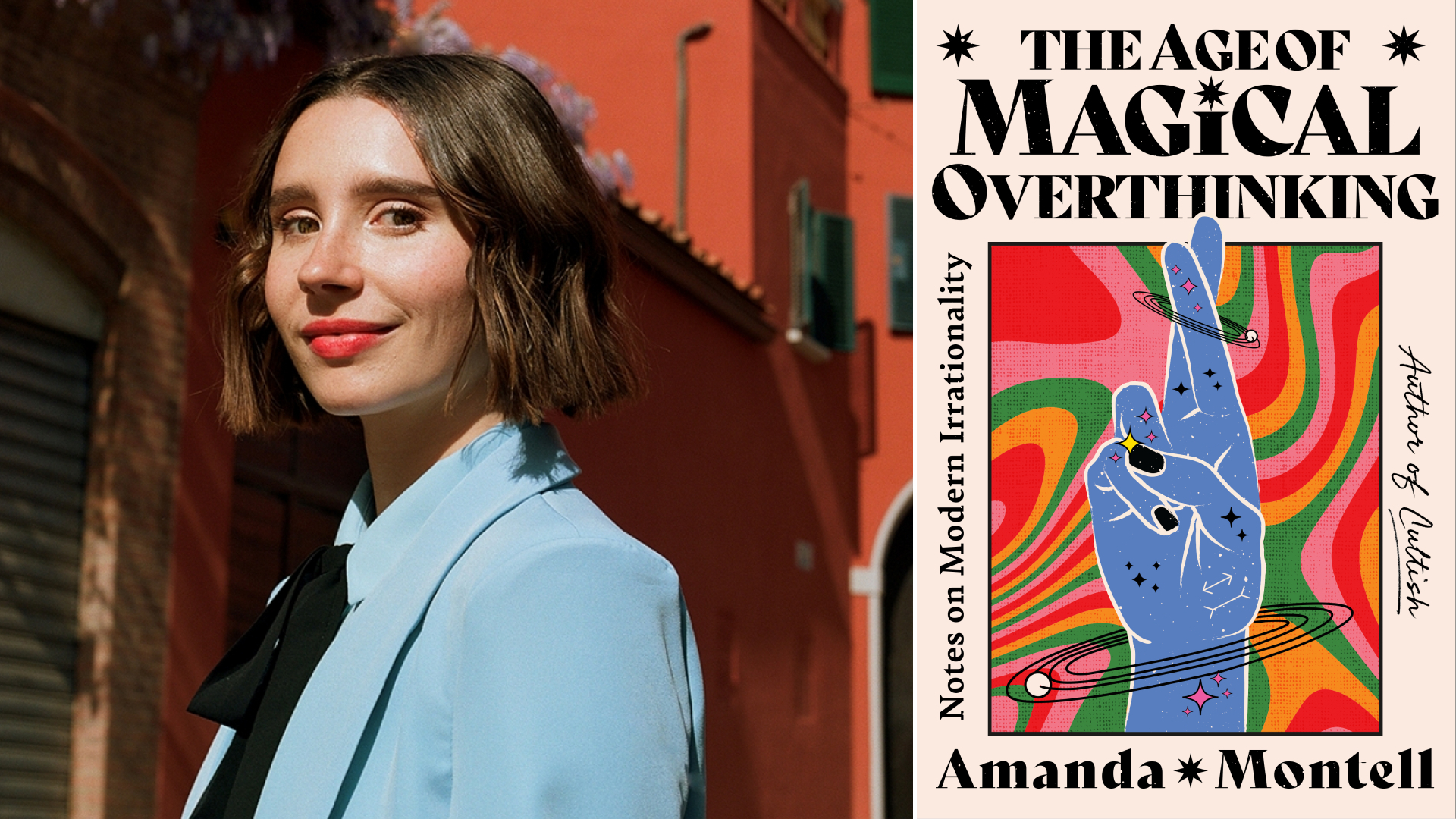Why We're Obsessed With the Handmade
"Daily life has only become more automated, but the innate yearning for physical handprints has not disappeared," writes Amanda Montell in 'The Age of Magical Overthinking'.


In her new book, The Age of Magical Overthinking: Notes on Modern Irrationality, author Amanda Montell explores the state of the modern mind. The below excerpt from The Age of Magical Overthinking, out April 9, examines our obsession with the handmade.
The Life-Changing Magic of Becoming a Mediocre Crafter
A therapist in a large beaded necklace once told me over video chat that in order to yank your attention into the present, you’re supposed to do things with your hands. “Watercolors, card tricks, any hands-on hobby,” she said, her kind eyes squinting glitchily over Zoom. I winced at the suggestion, as a sentiment from my hometown hero John Waters leapt to mind: “The only insult I’ve ever received in my adult life was when someone asked me, ‘Do you have a hobby?’ A HOBBY?! DO I LOOK LIKE A FUCKING DABBLER?!” I wanted to sneer, but then I remembered: Nora Ephron loved to cook. Michelle Obama has her knitting. Greta Thunberg allegedly cross-stitches for relaxation between climate justice meetings with presidents. None of it is what they’re known for, but it’s what they love. What they do with their hands. “A hobby,” I told the therapist. “I’ll think on it.”
Unfortunately, I believe I might be the single worst crafter of all time. Since childhood, my instincts as a painter, a French braider, a friendship bracelet maker have been practically non-existent. I recognize that a woman publicly admitting to her lack of domesticity is still taboo, or at least unflattering, like someone confessing they don’t like dogs. For the record, I have made heartfelt attempts at “dabbling.” During the craft boom of the 2020 lockdown, I managed to grow a small forest of basil, though I manslaughtered it within a matter of days. I tried pouring candles, but they reeked of funeral flowers. Upon burning one, I was blighted by a headache so enfeebling that I spent the rest of the afternoon supine in the dark with a peppermint lozenge. Casey wanted to help. He procured me a beginner’s pottery kit, then a loom. Neither was assembled. Dismayed by my own incompetence, I became obsessed with a category of “homesteading influencers,” young internet celebrities who seemed to possess every DIY skill that I didn’t. I grew particularly infatuated with one figure named Isabel, who produced weekly films about her life off the grid in the verdant forests of Washington State. In her early twenties with russet hair to her waist, Isabel built her own house by hand wearing a sundress and work boots, cultivated and cooked her own vegan cornucopias, weaved throw blankets from yarn she spun herself, and traveled into town for WiFi access once a week to upload.
The girl knew her way around a spinning wheel better than I knew mine around my own television remote. I was as enchanted by her as I was ashamed of myself. Crafting seemed to fulfill almost everyone else on earth but me. Why was I so incapable of this basic human joy?
Nothing satisfies the spirit quite like building something yourself, or at least helping to.
Then, like falling in love after a lifetime of loneliness, I discovered the art of flipping furniture.
A little under a year into quarantine, my best friend Racheli and I stumbled across the practice online. Or really, it stumbled toward us, and we lunged back. Some crafts like embroidery and dollhouse-making are painstaking, but furniture-flipping is broadstroked and flashy, the gratification instant. Perfect for an anxious dilettante. A brief tutorial: You start by purchasing used home goods—mirrors, lamps, accent chairs—for dirt cheap from yard sales and second-hand stores. You might even find viable candidates in the back of your closet. You form an eye for both neglect and potential. You gussy up your wares by slapping on a coat of paint or even just wiping the piece clean and staging it so it approximates something you’d find new for ten times the price. There are more advanced flipping techniques involving upholstery and power tools; assess your capabilities accordingly. Finally, do with the final product whatever you wish: Keep or sell. Give away to a friend.
Each Saturday, Racheli and I collected a batch of new tchotchkes, then descended upon the craft store, devoting our entire weekend to “restoring” in time to list the finished products on Facebook Marketplace Sunday night. The point was not to profit, and we almost never did, mostly breaking even but relishing the endeavor anyway like a catch-and-release fishing trip.
Stay In The Know
Get exclusive access to fashion and beauty trends, hot-off-the-press celebrity news, and more.
Of all our projects, my favorite flip began as a dusty seashell lamp the color of mucus. Racheli and I found it for $10 at a neighborhood Goodwill and decided to take a risk. Decor in the style of 1980s Miami was enjoying a wacky revival, so we seized the moment by painting the lamp a shade of atrocious Hubba-Bubba-Bubble-Tape pink. “This thing is fugly. I feel bad selling it,” said Racheli. Before the flip, we’d mentally priced the lamp at $20, but the moment we placed our grubby little paws on it, some primal ghost took over. By the time the final pink paint coat dried, we concluded that with the right viral TikTok, the lamp could sell for hundreds. Let me reiterate, this object was grotesque. It looked like SpongeBob SquarePants’s pet snail, Gary. Thirty minutes prior, we saw that plainly. Now, we were listing it on the internet for the average price of a bottle of Veuve Clicquot. For a moment, I thought I actually wanted to keep the lamp. For a moment, I thought I might leave my godless, city-slicked existence behind and move to the mountains to flip seashell lamps full-time. I’d wear tasseled kaftans and dwell in a yurt that doubled as my craft studio. I’d macramé shawls. I’d throw pottery. I’d keep goats. Finally, I’d master the loom. I’d invite influencer Isabel to come live with me and spend the next decade as her apprentice. For a moment, that seashell lamp illuminated a vision for my pastoral future. Hope swelled within me like a ripe peach.
Our lamp sold above asking price to a shiny-haired college student within an hour of posting. But it was never about the money. It was about that feeling. Finally, I grasped what that therapist meant. Nothing satisfies the spirit quite like building something yourself, or at least helping to. At the same time, nothing had ever warped my perception of “value” with such efficiency. What is it about a human hand?
The propensity to ascribe disproportionately high worth to items we helped create is a cognitive bias, known as the IKEA effect. Its delightful name is a homage to the Swedish furniture company whose affordable products require assembly. Spending long nights splayed on the floor, struggling to piece together IKEA Malm chests and POÄNG chairs is practically a coming-of-age ritual, a contemporary rite of passage as significant as the Amish Rumspringa. Erect your first anticlimactic IKEA dresser, and you finally know what it means to stitch a tiny fabric square to the quilt of humanity.
The IKEA effect was first documented in 2011, when a trio of Ivy League researchers demonstrated the intrinsic urge for people to bloat the valuation of products they helped construct. The experiment, led by Harvard behavioral scientist Michael I. Norton, invited consumers to build Lego sets, fold origami, and assemble IKEA boxes. Even if the participants expressed zero interest or enjoyment in DIY hobbies—and even if the results of their efforts were as shoddy as Racheli’s and my seashell lamp—as long as they saw their projects to completion, they swelled with satisfaction. The research subjects expressed willingness to pay more for the products they built than they would for objectively superior versions that arrived pre-assembled. “Participants saw their amateurish creations . . . as similar in value to the creations of experts, and expected others to share their opinions,” concluded the authors. Thanks to my days as a mediocre furniture flipper, perusing this study felt like looking in a funhouse mirror.
The IKEA effect was observed long before it was described. An oft-cited example comes from the mid-twentieth century, during the golden age of processed food. As the anecdote goes, in 1947, General Mills launched a new line of Betty Crocker instant cake mixes that tasted nearly indistinguishable from the stuff made from scratch. The product took off at first, but sales eventually slowed to a near halt. In a state of consternation, General Mills solicited the analysis of a Freudian psychologist, who determined that this sales decline was a result of guilt. Homemakers felt that if all they did was add water, the cake was not truly theirs. They couldn’t proudly tell their husbands and children that they’d prepared the fluffy confection with their own two hands. General Mills responded with an unexpected marketing pivot. They relaunched the instant cake mixes with a new slogan, “Add an Egg.” Now, baking was easy but not too easy. Betty Crocker’s sales soared.
The details of this eggy legend are up for debate (for one, adding fresh eggs isn’t just a marketing ploy—it really does improve the taste of instant cake); but, its takeaway message stands: We like things better when we’ve had a hand in creating them. According to the IKEA effect’s coiners, this fact isn’t due merely to guilt, but rather something more existential. What truly displeased Betty Crocker consumers, they argued, was the sobering shock of insignificance. New technology insinuated that mothers’ home cooking, and thus mothers themselves, were unnecessary. No one likes “the feeling of being rendered...irrelevant,” commented Norton et al. The cake mix did not technically require additional ingredients, labor, or expertise, but that egg fulfilled consumers’ desire for “effectance,” the spiritually satisfying notion that we caused something to happen in the world. The egg made people feel like they mattered.
Since the 1950s, daily life has only become more automated, but the innate yearning for physical handprints has not disappeared. In theory, the IKEA effect is responsible for the entire DIY renaissance. The term “do-it-yourself” first bubbled up in consumer discourse in the early 1910s, but throughout mid-century America, as baking your own bread and renovating your own basement became not just economical practicalities but creative diversions, the phrase entered everyday conversation. By the 1970s, the coolly abbreviated “DIY” subculture gave rise to self-published books and zines, mixtape trading, “reduce, reuse, and recycle” practices inspired by the burgeoning environmental movement, and endless crocheted handicrafts.
I recognize that a woman publicly admitting to her lack of domesticity is still taboo, or at least unflattering, like someone confessing they don’t like dogs.
With the launch of Pinterest in 2010, DIY took on major significance. Domestic “hacks” boomed from a casual hobby to a bona fide lifestyle. Since the early aughts, companies have capitalized on the IKEA effect, no longer treating customers as mere receivers of value but partners in its creation. Think of the colossal meal kit market: Subscription DIY-dinner companies like Blue Apron and Home Chef hypnotize busy professionals who don’t have time to cook into proudly chopping, sautéeing, and braising a new recipe each night for nearly the same price as takeout (though not at all the same feeling). There’s also the crowdfund- ing industry. Sites like Kickstarter and GoFundMe have lost millions of mini-“investor” dollars due to failed and never-launched products, but the hope of helping to birth a new video game or nano drone is still so arousing that the industry has soared to over $20 billion. One could argue that the IKEA effect is the whole driving force behind TikTok’s popularity. The platform’s interactive atmosphere— including its “stitch” feature and hyper-engaged comments sections—encourages audiences to become co-creators, producers, and critics. Mainstream artists, too, have increasingly allowed patrons to shape their output. In 2018, at the urging of a Twitter fan, the band Weezer released a cover of Toto’s “Africa,” which became their first Billboard #1 hit single in ten years. It inspired an entire smash-hit covers album that practically relaunched the group’s career. The album received mixed reviews from critics, but the magic was not in the music—it was in the co-creation.
The world is growing more user-generated. This is not necessarily because artists and entrepreneurs are out of ideas; it’s because they recognize that brands are “communities” now, and if consumers don’t feel seen and held by their communities, they won’t feel important. They won’t come back. To feel like we’re contributing to the world, lending a hand at cultivating our vegetable medleys and video games, is searingly important. We need the allegorical egg. The egg gives us purpose. The egg tells us we deserve to be here. But what happens when the egg becomes so obsolete that we can’t even pretend to need it anymore?
In 2020, a sound bite exploded on TikTok that went, “Darling, I have no dream job. I do not dream of labor.” (The quote’s origins are unverified. Shocking for TikTok, I know!) The moment was one of widespread ennui. The term “languishing” had taken off in a New York Times piece by Adam Grant, assigning a validating label to a chronic cultural plague. We were failing to make progress, so people decided to critique the value of progress in the first place. A whole category of viral memes spun off the original. Among my favorites read, “I do not want to be a woman in the work force!!! I want to be a little creature drinking from a creek!!!!!!” Indeed, conflating self-worth with employment is one of capitalism’s wiliest tricks, but research finds that both humans and little creatures by creeks do appreciate (if not dream about) a certain amount of labor. In a 2009 survey, responders rated their jobs among their least pleasurable daily activities, but also their most rewarding. That might sound like toxic productivity brainwashing, but a similar intuition exists in nonhumans—even rats and starlings prefer food sources which require exertion to obtain. Some jobs are inherently more satisfying than others: A 2023 analysis of American time use from the Bureau of Labor Statistics concluded that out of all career pursuits, the highest levels of happiness were reported by loggers, a line of work involving both labor by hand and the curative outdoors. (The most stressful, least gratifying occupations were finance, insurance, and most of all, law.) Jobs that either don’t click with some natural facet of the human spirit, or don’t produce a livable income, are about as “rewarding” as a lab rat toiling through a gray-walled maze, only to receive half a crumb.
Like the sunk cost fallacy, the IKEA effect is at its core another effort justification bias. How we love to defend our most expensive, time-consuming, irreversible choices. The ironic link between a task’s arduousness or permanence and our eagerness to rationalize it is why, when faced with a heavy decision—like whether or not to attend grad school or have another kid—psychologists caution against asking the advice of someone who just did it themselves. If a person endures involuntary pain on their path toward achievement (say, if they get a paper cut while folding origami, or are forced to finish out a prison sentence), that won’t make them appreciate the end result any more. But if they willingly endure suffering (if they opt to get the paper cut, or throw a wedding the price of a down payment), that paper crane will start to look like it’s made of porcelain.
The IKEA effect isn’t all outright fantasy. The social connection it fosters is real, especially when the end product is tangible. As much as automation and specialization have benefited society, they risk limiting our social engagement. DIY projects offer the chance for more holistic, communal modes of interaction. Furniture flipping with Racheli was pure jubilance even though we were bad at it, because we did it together. Adorably, the Norton study found that after completing their origami and Lego structures, participants expressed a desire to show them to their friends. It doesn’t take a psychologist to intuit that sharing an object you made inspires much more pleasure than displaying something you bought or something that technically belongs to a large company. This is even and especially true when the creation didn’t turn out quite as planned.
As a thirtieth birthday present to myself, I procured my first ever work-from-home desk and chair (from Facebook Marketplace, obviously). The chair, chosen for its sleek beechwood-and-steel swivel, was not particularly cozy for the derriere, but feeling high on my new rig and emboldened by my furniture-flipping stint, I decided to try and DIY myself a seat cushion. I purchased a needle, thread, and a yard of faux suede fabric in a peacock-green shade. Then, repurposing the innards of a neglected dog toy, I sutured a pillow the size and shape of a personal pizza. This seat cushion is the most unremarkable object in my home. I believe it is a masterpiece. The seat cushion is every instant Funfetti cake on earth. It is my Sistine Chapel. I show it to everyone. When friends and family come to visit, I lead them to my dainty home office as if about to unveil a sculpture chiseled from marble, and when I gleefully lift the wilted disc from my chair, they smile at me the way one who doesn’t care for children humors their little niece’s living room “play.” I see this happen. I do not care. I am prouder of my seat cushion than I am of this book. I was practically foaming at the mouth to tell you about it. I am sitting on it right now. (Needles and fabric do wonders for the spirit. A study published in the British Journal of Occupational Therapy surveyed over 3,500 knitters and found that 81 percent of participants with depression reported feeling happy post-knitting. More than 50 percent said they felt “very happy.”)
Seat cushions and seashell lamps aren’t the world’s costliest objects, but the IKEA effect also holds for higher price brackets. The Norton study noted homeowners’ pride in their tawdry home improvements—lopsidedly laid walkways, sloppily constructed fire pits—believing they’ll make the house more attractive to friends and prospective buyers, even when they do just the opposite. I go window-shopping for overpriced homes on Zillow almost every day and have seen some kitschy personalizations: self-assembled tiki bars, an amateur pizza oven shaped like a hippopotamus. I feel for the realtors who chose not to inform the owners that those quirks weren’t quite the assets they thought they were. (My seat cushion absolutely is, though.) These imperfections may not be optimized for profit, but they are what make us wince and laugh and spark conversation. Flaws are what give a thing life.

'The Age of Magical Overthinking' is Montell's third book.
One day fairly soon, some argue that AI-generated art will surpass humans’ abilities so greatly that no egg could ever make up for our impertinence. In 2018, one of the first AI paintings to be sold at auction went for $432,500. On the bottom right of the canvas, its signature read min G max D x [log (D(x))] + z [log (1 -D (G(z)))], part of the code that produced it. Titled Edmond de Belamy, the image depicts a portly French gentleman in a black coat and white collar—the painting style frenetic, distorted, almost nineteenth-century Impressionist but some quality just askew. Cock your head to the right, and the portrait narrowly resembles “Monkey Christ,” a botched restoration of a 1930s Christian fresco that turned out so ludicrously simian, it went viral in the late 2010s, attracting a wryly worshipful cult following. Tourists now flock to the small town in Spain where “Monkey Christ” is displayed, just to bask in its blundered glory.
It’s hard to imagine humans rallying around an AI portrait with “Monkey Christ”-level verve. Edmond de Belamy might have been worth half a million dollars to a Beverly Hills art collector, but I remain unconvinced that a robot-generated art piece could emit the je ne sais quoi necessary to lure pilgrims. For all its sophistication, a machine can’t guffaw at the absurdity of sewing a bad seat cushion and then showing it off to its friends. That kind of effrontery is an inside joke shared by humans alone.
In 2019, a fan of the Australian musician Nick Cave wrote in to his blog and asked, “Considering human imagination the last piece of wilderness, do you think A.I. will ever be able to write a good song?” Good meaning more than technically impressive. Cave was dubious. “What a great song makes us feel is a sense of awe,” he responded. There’s that notion of awe again; Cave characterized it as being “almost exclusively predicated on our limitations. . . . It is entirely to do with our audacity as humans to reach beyond our potential.” By Cave’s measure, as impressive as posthuman creativity might be, it “simply doesn’t have this capacity. How could it?”
How could it? The question haunted me. One morning in early 2023, Casey and I found ourselves puzzling through the answer as we drove home from our favorite coffee shop in L.A., whose iced cortados are a thing of immeasurable beauty. Casey is a film composer, so the creation of music is of both material and existential concern to him. Heading east, as a talon of marigold sunlight pierced through our windshield, we rummaged for reasons why a machine could never replicate the soulfulness of human touch, only to realize with sorrow that perhaps those reasons don’t exist. It’s no stretch to picture AI figuring out how to approximate the texture of our audacity, or invent its very own, well enough to inspire awe. As Casey and I pulled into the driveway, a film of melancholy draped over us like a top sheet. “It just makes everything I do feel so small,” he exhaled.
Lingering in park, Casey thumbed his coffee condensation. For us, this type of digital-age nihilism is inevitable, but we treat it like a heavy water jug. When one of us gets too tired to carry it, the other takes a turn. Then, it becomes the job of the unburdened partner to distract the other, remind- ing them that life can feel weightless, too. So I told Casey that a robot could compose the most enchanting concerto of all time, and it would never be as valuable to me as the nightly waltzes he improvises on our upright Wurlitzer for the sheer fact that he’s the one making them. It feels good to paint an old seashell lamp alone. It feels better to have a doting witness.
In theory, the IKEA effect is responsible for the entire DIY renaissance.
Placing us in competition with technology might not even be the most functional line of questioning to pursue anyway. In 2014, the singer Claire L. Evans called our judgments of AI’s ability to “pass” as human musicians “almost exquisitely myopic.” Our cars do not “pass” as horses, but they do an excellent job carting us around. PowerThesaurus.com does not “pass” as my brain, but I happily used it while writing this book. Combine hyper-advanced technology with humans’ visceral inventiveness, and you get sorcery. The best instant cake mix in the world can’t pipe a ridiculous inside joke in glow-in-the-dark icing on top, but with all that time you saved not baking the thing, you can have your cake, and well, you know the rest.
The winter that I began my second draft of this book, I was stuck home alone for a week with COVID and decided to pass the time testing the emotional limits of ChatGPT. In our most notable exchange, I asked the chatbot what it believed to be humans’ versus AI’s single greatest strengths. It responded that AI’s best asset is reason, while humans’ is love. I found the answer poignant, though I’m not convinced it’s true. Who says we have to choose?
Perhaps we will always feel like we’re on the outermost brink of losing touch with our primal selves, like any second now, the egg could disappear around the corner for- ever. Perhaps we should get used to existing in that state. I suspect we’ve already been there for a long time. In 1962, Sylvia Plath suggested a critique of the exceptionalist attitude that society had, just then, reached an unprecedented point of inhumanity. In a short essay titled “Context,” Plath problematized what she called “headline poetry”— choosing to reference the era’s major political conflicts (Hiroshima, the Cold War) so directly and sensationally in poems, as if the mid-twentieth century was sure to go down as the most worrying time in history and should be immortalized as such. Plath challenged readers to widen their lens. “For me,” she contended, “the real issues of our time are the issues of every time—the hurt and wonder of loving; making in all its forms—children, loaves of bread, paintings, buildings; and the conservation of life of all people in all places, the jeopardizing of which no abstract doubletalk of ‘peace’ or ‘implacable foes’ can excuse.” It is perhaps no coincidence that Plath wrote this essay the same year she began keeping bees, a craft which inspired many of her most iconic poems. Love, survival, creation by hand. Technology changes faster than the lifespan of a honeybee, but we are the hive.
Excerpted from The Age of Magical Overthinking: Notes on Modern Irrationality by Amanda Montell, published by Atria/One Signal Publishers. Copyright © 2024 by Amanda Montell.

Rachel Burchfield is a writer, editor, and podcaster whose primary interests are fashion and beauty, society and culture, and, most especially, the British Royal Family and other royal families around the world. She serves as Marie Claire’s Senior Celebrity and Royals Editor and has also contributed to publications like Allure, Cosmopolitan, Elle, Glamour, Harper’s Bazaar, InStyle, People, Vanity Fair, Vogue, and W, among others. Before taking on her current role with Marie Claire, Rachel served as its Weekend Editor and later Royals Editor. She is the cohost of Podcast Royal, a show that was named a top five royal podcast by The New York Times. A voracious reader and lover of books, Rachel also hosts I’d Rather Be Reading, which spotlights the best current nonfiction books hitting the market and interviews the authors of them. Rachel frequently appears as a media commentator, and she or her work has appeared on outlets like NBC’s Today Show, ABC’s Good Morning America, CNN, and more.
-
 Why Prince Andrew Attended Royal Family's Easter Service
Why Prince Andrew Attended Royal Family's Easter ServiceIt was previously alleged King Charles's "patience was wearing thin" with his brother.
By Amy Mackelden
-
 How Princess Eugenie Took Style Tips From Meghan and Kate
How Princess Eugenie Took Style Tips From Meghan and KateFrom her nude heels to her bodycon dress.
By Amy Mackelden
-
 Rihanna Matches Her Canadian Tuxedo to a Denim Dior Tote
Rihanna Matches Her Canadian Tuxedo to a Denim Dior ToteThe superstar accessorized her triple denim outfit with strappy snakeskin heels.
By Amy Mackelden

